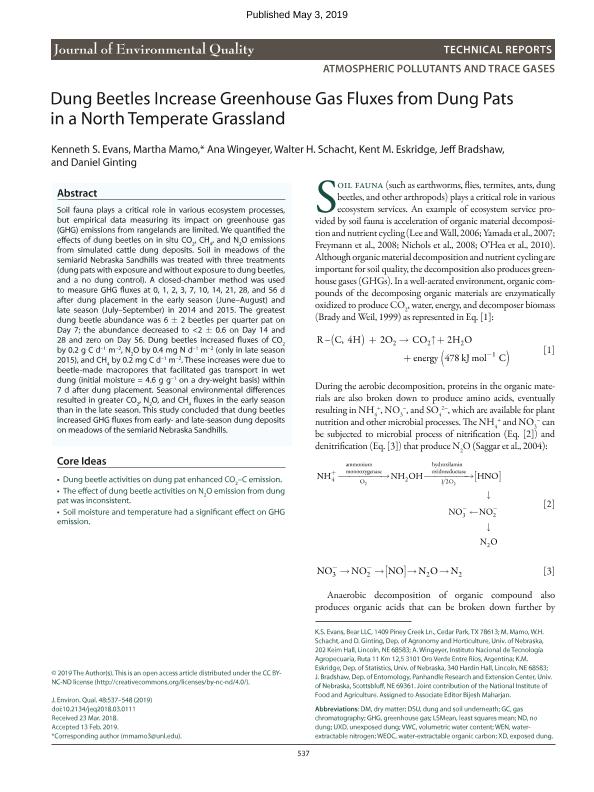Artículo
Dung beetles increase greenhouse gas fluxes from dung pats in a north temperate grassland
Evans, Kenneth S.; Mamo, Martha; Wingeyer, Ana Beatriz ; Schacht, Walter H.; Eskridge, Kent M.; Bradshaw, Jeff; Ginting, Daniel
; Schacht, Walter H.; Eskridge, Kent M.; Bradshaw, Jeff; Ginting, Daniel
 ; Schacht, Walter H.; Eskridge, Kent M.; Bradshaw, Jeff; Ginting, Daniel
; Schacht, Walter H.; Eskridge, Kent M.; Bradshaw, Jeff; Ginting, Daniel
Fecha de publicación:
05/2019
Editorial:
American Society of Agronomy
Revista:
Journal of Environmental Quality
ISSN:
0047-2425
Idioma:
Inglés
Tipo de recurso:
Artículo publicado
Clasificación temática:
Resumen
Soil fauna plays a critical role in various ecosystem processes, but empirical data measuring its impact on greenhouse gas (GHG) emissions from rangelands are limited. We quantified the effects of dung beetles on in situ CO2, CH4, and N2O emissions from simulated cattle dung deposits. Soil in meadows of the semiarid Nebraska Sandhills was treated with three treatments (dung pats with exposure and without exposure to dung beetles, and a no dung control). A closed-chamber method was used to measure GHG fluxes at 0, 1, 2, 3, 7, 10, 14, 21, 28, and 56 d after dung placement in the early season (June-August) and late season (July-September) in 2014 and 2015. The greatest dung beetle abundance was 6 ± 2 beetles per quarter pat on Day 7; the abundance decreased to <2 ± 0.6 on Day 14 and 28 and zero on Day 56. Dung beetles increased fluxes of CO2 by 0.2 g C d-1 m-2, N2O by 0.4 mg N d-1 m-2 (only in late season 2015), and CH4 by 0.2 mg C d-1 m-2. These increases were due to beetle-made macropores that facilitated gas transport in wet dung (initial moisture = 4.6 g g-1 on a dry-weight basis) within 7 d after dung placement. Seasonal environmental differences resulted in greater CO2, N2O, and CH4 fluxes in the early season than in the late season. This study concluded that dung beetles increased GHG fluxes from early- and late-season dung deposits on meadows of the semiarid Nebraska Sandhills.
Palabras clave:
CO2
,
N2O
,
Temperature and Moisture
Archivos asociados
Licencia
Identificadores
Colecciones
Articulos(SEDE CENTRAL)
Articulos de SEDE CENTRAL
Articulos de SEDE CENTRAL
Citación
Evans, Kenneth S.; Mamo, Martha; Wingeyer, Ana Beatriz; Schacht, Walter H.; Eskridge, Kent M.; et al.; Dung beetles increase greenhouse gas fluxes from dung pats in a north temperate grassland; American Society of Agronomy; Journal of Environmental Quality; 48; 3; 5-2019; 537-548
Compartir
Altmétricas



